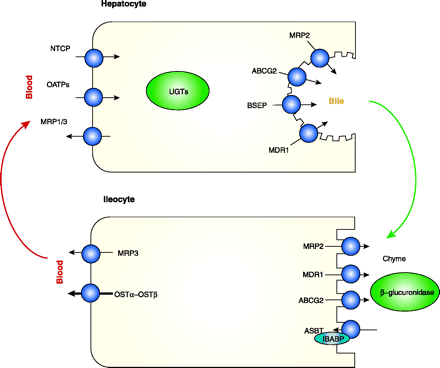
- Institution: Stanford Univ Med Ctr Lane Med Lib/Periodical Dept/Rm L109
- Sign In as Member / Individual
The Ileocyte Basolateral Organic Solute Transporter (OSTα–OSTβ) Complex: Finding The Missing Link in Enterohepatic Circulation

Simplified schematic depiction of transporters involved in enterohepatic circulation of bile acids and drugs. Arrows (black) indicate the direction of substrate movement through transmembrane transporters. Drugs undergoing enterohepatic circulation are taken up into the hepatocyte by NTCP or OATPs. Once inside the cell, drugs may be glucuronidated by UGTs, then excreted into bile by MRP2, ABCG2, and/or MDR1. β-Glucuronidase, present in bacterial flora in the gut, hydrolyzes the glucuronide conjugate back to the parent compound, which is then reabsorbed by ileocytes (2, 3). OSTα–OSTβ is thought to have a much more important role than MRP3 in impacting basolateral bile-acid transport in ileocytes (5). The ileal bile acid binding protein (IBABP) is cytoplasmically attached to ASBT in a multimeric complex and plays an important role in intracellular binding and trafficking of bile acids (2, 3). NTCP, Na+-taurocholate cotransporting polypeptide; OATP, organic anion transporting polypeptide; MRP, multidrug resistance–associated protein; ABCG2, ATP-binding cassette, subfamily G protein 2; BSEP, bile salt export pump; MDR1, multidrug-resistance 1; OSTα–OSTβ, organic solute transporter alpha and beta complex; UGTs, uridine-5′-diphosphate (UDP)-glucuronosyltransferases; IBABP, ileal bile acid binding protein.


